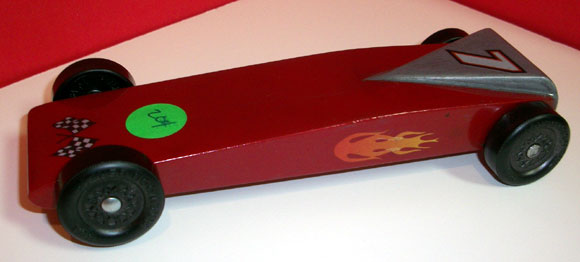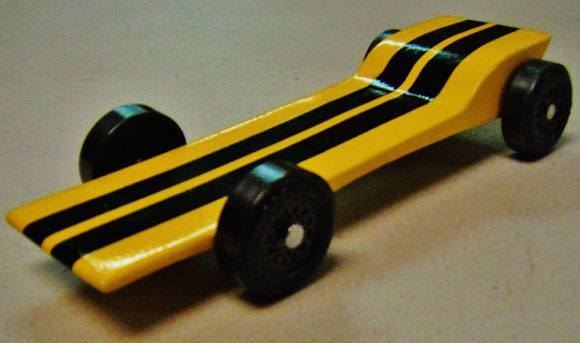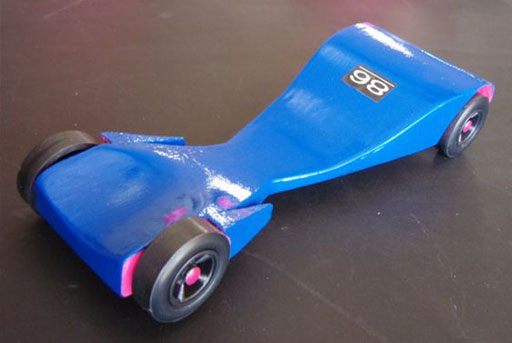– Feature Article – Solenoid Start Gate: Are Races More Consistent?
– Speed Tip – Extending the Front
– Pinewood Derby Car Showcase
– Q&A
Solenoid Start Gate: Are Races More Consistent?
By Randy Davis
Solenoid Start Gates came on the market a few years ago. These mechanisms use a solenoid (electrically activated switch) to release the starting gate at the press of button. The benefits of a Solenoid Gate include:
- Enabling the computer software to release the gate (as opposed to a computer operator activating the heat, and then another operator opening the gate).
- Allowing audience members or car owners to activate the gate remotely (adds some additional fun and participation to the pinewood derby).
- Potentially improving the consistency of heats. Depending on the type of gate release mechanism, by eliminating the need for a person to operate the gate, consistency may be improved.
This latter benefit is what intrigued me. I run several experiments per year, and a big issue with experiment validity is eliminating factors that can adversely influence the results. So, eliminating inconsistency in gate operation should improve the validity of experimental data.
Freedom Track Start Gate
I have a two lane, aluminum, Freedom track. The gate on the track works fine, if the operator uses care when opening the gate. But if the operator is not careful, the track will be shaken when the gate is operated.
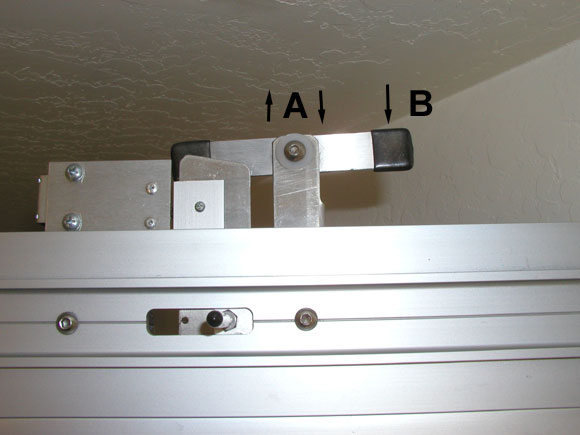
Referencing Photo 1, if your hand is placed at point A and then slightly rotated, the gate releases and the track remains stable. However, if the gate lever is pulled at point B (the natural place to operate the gate), the starting section of the track will shake.
Solenoid Start Gate From New Directions
For the testing I acquired a GLM Start Gate from John Shreffler at New Directions.1 This gate was specifically designed for the Freedom Track start gate. The gate installed with minimal effort; I had it up and running in 20 minutes.
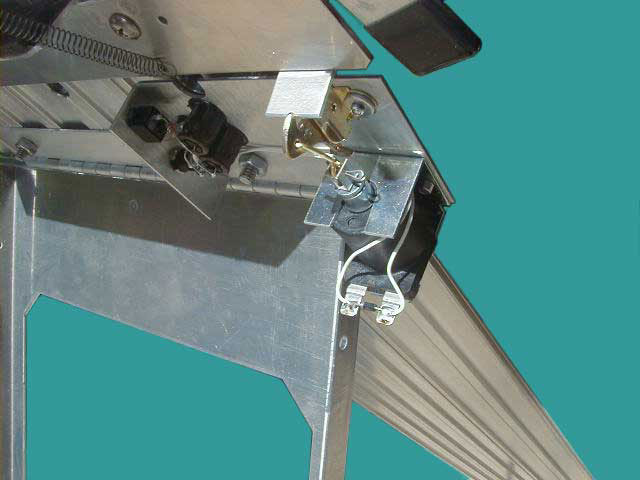
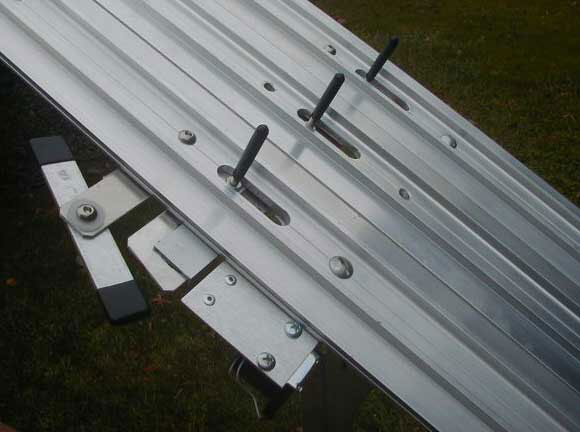
In Photo 3, for reference the manual release arm is still present. It can be removed, but like the photo I left mine in place so that I could switch back and forth from manual to auto. For manual testing I used a rubber band to pull the solenoid latch out of the way.
Test Setup
The car used in the test (Photo 4) was equipped as listed below. I chose this car as the needle axles and outlaw wheels result in very consistent performance from heat to heat.
- Five ounces with a one inch balance point
- Extended wheelbase
- Three wheels on ground, set to rail ride
- Needle Axle Outlaw Wheels
- Krytox 100 Lube
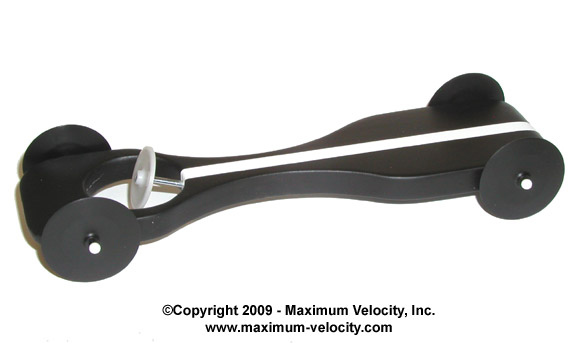
For the experiment, I ran five heats with the manual gate (carefully rotated at “A”), then five heats with the Start Gate. Next, I ran five heats with the manual gate (quickly pulled at “B”), then five heats with the Start Gate.
Results
The standard deviation2 was calculated for each of the four sets of five runs. The results are shown below:
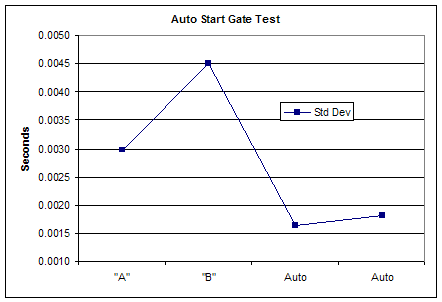
As seen in the chart the deviation was smallest when the Solenoid Start Gate was used. The deviation was larger when the manual gate was used carefully, and even greater when the gate was used in the natural way.3
Conclusion
Clearly, gate consistency does affect heat times. So if gate consistency is important to you, consider adding a solenoid start gate to your track.
1Click Here for more information on the GLM Start Gate. New Directions offers a similar gate for other tracks.
2A statistical calculation showing how much the data deviates from the average. A larger number means that the data has a greater deviation from the average.
3The results of this test are only applicable for a two-lane Freedom Track. Results may be different for Freedom Tracks with more lanes (more stable), and for tracks using a different type of manual gate.
Speed Tip
Extending the Front
By Bill Klingler
If your race rules do not limit the distance between the ends of the block and the axle slots, you can cut off the back of the block and move it to the front. So, instead of the stock distance of 1-11/16 inches between the front end and the front axle slot, you will now have a distance of 2 inches This should give the car a higher velocity entering the horizontal run because the center of mass can be higher up the slope when the car is staged.
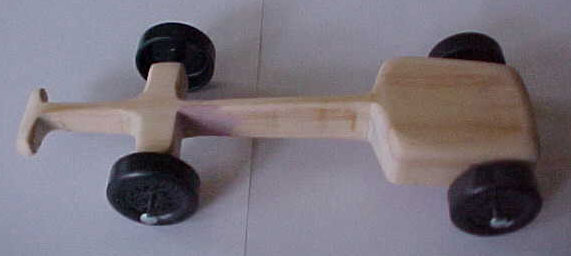
Pinewood Derby Car Showcase
Wedge Turbo – Bill Odom
My grandson and I built this car from your plans and raced it earlier this year. He finished first in his den and second overall. We had already finished a car when I found your web site. I purchased several of your tools, and we built a second car. I ran the first car in the parent/sibling class and finished a close second, but noted the times would not have placed that car in his pack. My grandson’s car won 11 of the 12 heat races with one second place, which was to the eventual overall winner. My post race inspection revealed several areas that I can improve upon for next year’s race. Thanks for all of your information, assistance and great tools.
Black n’ Yellow – Ronnie Cutler
This year we decided to stick with a slick, low profile, and just all around cool car. Not only does it look spectacular, it performs! It was undefeated and went on to win first overall in districts — all thanks to Maximum Velocity!
Speedy 86 – Rick Ellis
This year our Awana Grand Prix used your kits. This car was the fastest in the Open Division and was the fastest overall in the Grand Finals where the winners of all the divisions raced against each other. It also won Best Workmanship in the Open Division.
I used weights, tools, and techniques from Maximum Velocity, and have since 2008. Since then either my car or a car I helped build has won the Open Division and/or the Grand Finals each year. Thanks for all your help and for your great site.
Q&A
I have now come to the conclusion, that no situation that ever arises regarding the pinewood derby will ever surprise me. That said, I was wondering if you could offer any advice on the following. My friend and I recently completed his wedge for his daughter’s powder puff derby. He ordered the pre-cut standard wheel base axle hole Wedge from you, and except for some graphite, the car is ready to go.
Then yesterday evening, the girl’s leader sent them an e-mail with the “rules” for this year’s event. This is the first time the rules were sent, and yes, two days before the weigh-in. One of the rules states that you MUST use axle slots. We asked if our drilled holes were okay, but were told regardless that axle holes will not be allowed. Any ideas on how to turn drilled holes into axle slots without totally screwing up the car? We are now down to hours until weigh in. Figured I would throw this out there just in case you had any thoughts.
Sorry to hear about the issue. One way to solve the problem is to use a saw to cut slots into the existing holes. If the blade width is a bit smaller than the hole diameter, then the axles will still follow the path of the holes.
In most cases, two hacksaw blades are about the right width, and typically you can mount two blades on one frame. You may need to squeeze the blades together in the center with a binder clip. Make a test cut first on a scrap block to make sure the width of the cut is okay.
Strike a line on the bottom of the car and saw into the holes. The accuracy of the cuts can be increased by clamping a piece of wood with a straight edge along the pencil line. Then hold the blade against the block to keep the cut straighter.
I need your help with a condition in my son’s car. We ran our car at the pack race. It has a balance point of 1/2 to 5/8 inch in front of the rear axle. Tungsten was used for weight.
The car took off fast and tracked straight for the first 10 feet or so, but as it transitioned to the flat part of the track the rear end started to wiggle, bouncing off the rails the remainder of the race, losing speed and most or all of the lead every time. It won three heats and took second once. The tiebreaker was lost by a mere fraction of an inch, after having over a car length lead.
The car qualified for the Regional and I need some advice on how to resolve this condition. I believe it could be an axle issue, but it goes straight on my test bench. Is it possibly an alignment issue or could the wheels be “binding” on the axles because they were bent using the rail rider, Could it be a weight placement issue?
What is likely happening is that the balance point is too far back for the alignment setup. As the car hits the flat section, there is not enough weight on the front to keep the front axles pressing onto the wheel bores. So, essentially, the car is steering with the rear wheels.
This can be solved in one of two ways.
- Shift the weight forward so that the balance point is closer to 1 inch in front of the rear axles (maybe 7/8 inch). This will shift some weight forward so the front wheels will steer the car.
- Adjust the steering to rail-ride somewhat aggressively. You would need to steer the front wheels so that the car drifts left or right about 5 to 6 inches over 8 feet. Having one of the front wheels on the rail tends to keep the car more stable so that it can handle the extra weight on the rear. This solution is not as reliable as solution 1, unless you can actually test the car on a track.
Another thing to check is to make sure that the bend of the rear axles is truly at the 12 o’clock position. You can determine this by rolling the car backward and forward and watching to see if the wheels move to the axle heads when the car is rolled in both directions.
Want Answers?
Do you have a pinewood derby-related question? If so, e-mail us your question.We answer all questions by e-mail, but not every question will appear in the Q&A section of the newsletter.
Back Issues
Are you a new subscriber, or have you missed some of the previous newsletters? Don’t miss out; all of the issues for Volume 5 through Volume 17 are posted on our web site.
Newsletter Contributions
We welcome your contributions. If you would like to contribute an article, a web site review, a speed tip, or a pinewood derby memory, please e-mail us.
Subscription Information
The Pinewood Derby Times is a free e-newsletter focused on pinewood derby racing. It is published biweekly from October through March.
If you haven’t already done so, please forward this issue to your pinewood derby friends. But please don’t subscribe your friends. Let them decide for themselves. Thanks.
If this newsletter was forwarded to you, why not subscribe to receive this newsletter. There is no cost, and your e-mail address is safe, as we never sell or share our distribution list.
To subscribe, send a blank e-mail to
[email protected]
You will receive a confirmation e-mail. Reply to the confirmation e-mail and you will start receiving the Pinewood Derby Times with the next issue.
Randy Davis, Editor, Pinewood Derby Times
E-Mail: [email protected]
(C)2018, Maximum Velocity, Inc. All rights reserved. Please do not reprint or place this newsletter on your web site without explicit permission. However, if you like this newsletter we grant permission, and encourage you to e-mail it to a friend.
Maximum Velocity disclaims any personal loss or liability caused by utilization of any information presented in this newsletter.
The Pinewood Derby Times is not specific to, and is not affiliated with the Boy Scouts of America, YMCA, Awana, or any other organization.
(R)Maximum Velocity is a registered trademark of Maximum Velocity, Inc.
(R)Pinewood Derby is a registered trademarks of the Boys Scouts of America.
(R)Awana is a registered trademark of Awana Clubs International.
All other names are trademarks of their respective owners.

